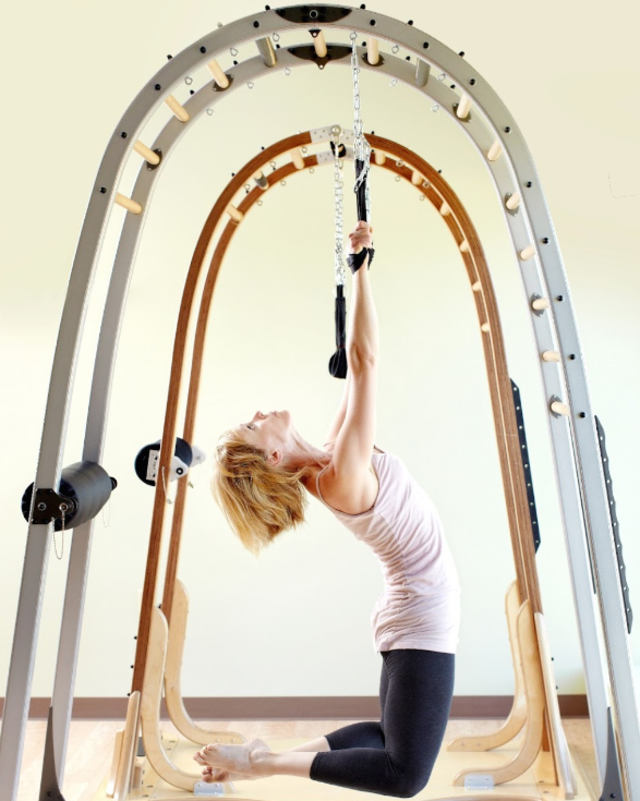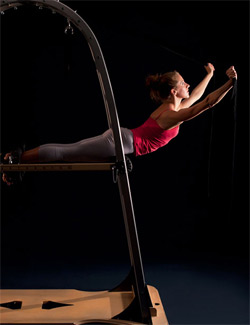The Downside of Gyrotonic
It’s pricey. Private classes are expensive, often starting at £45 a session, which makes a one-on-one Pilates class look cheap at an average £29.
Not very many teachers. If you are keen, you may find yourself having to travel quite far to get your fix.

Not particularly sociable. Gyrotonics requires a degree of commitment, yet it’s a relatively solitary form of exercise. Group classes are rare since the machines are so big. If you prefer the support of exercising in a group, you could seek out gyrokinesis classes instead.
It can be frustrating. Unless you’ve got really good co-ordination, picking up the different circular movements can be a bit like rubbing your stomach while you pat your head. You need to give yourself time to see your body change as you learn the different moves.
The benefits of Gyrotonic
Improves posture
Sports medics have attributed a more upright and elegant posture to the continuous involvement of the supportive muscles as they are strengthened and stretched.
Puts no stress on joints
Gyrotonics is beneficial for anyone suffering from joint pain because the unique way of securing the pulleys on the GXS machines allows movement without impact.
Leads to better co-ordination
The major muscle groups work together as well as interdependently, which, over time, leads to increased coordination with more efficient muscle recruitment.
Lifts your spirits
Fans attribute increased energy and raised spirits to the circular, spiralling motions and specific individual breathing patterns, which help relax tight muscles and stiff joints.
Gives you full spinal mobility
Gyrotonic movements free the spine to move in all directions, so improving back suppleness.
Working out can be so linear: Treadmill, stair climber, bike path … even yoga and Pilates mats steer you into moving along an axis.
If you’ve ever felt the urge to break out of “front-facing” workouts (notice how different you feel when you dance vs. work out?), Gyrotonic is a workout to try. Derived from words for “circle” and “stretch,” Gyrotonic works your body in a decidedly nonlinear way through a fusion of expressive-looking circular movements. Combining elements of dance, yoga, swimming, t’ai chi and gymnastics, it’s a liberating experience — a way to exercise outside the lines.
“There’s something about the 360-degree orientation that wakes up the spirit,” says Janet Rupp, a four-year Gyrotonic student at White Cloud studio in Boulder, Colo., who shifted to Gyrotonic from Pilates and hiking at age 58.
“It’s playful and fluid,” Rupp adds. “We tend to take ourselves so seriously. This adds lightness to life.” That’s the intention behind the Gyrotonic method developed by Juliu Horvath, a Romanian-born dancer, swimmer and devoted yogi who introduced Gyrokinesis, or “ Yoga for Dancers,” to elite performers in New York City in the 1970s.
Horvath expanded on the yoga-like floor work (which also includes exercises done on a padded stool) as the basis for his Gyrotonic Expansion System. This workout equipment’s handles and pulleys enable sweeping, arcing movements that contrast the back-and-forth motion of most weight equipment or Pilates Reformers.
Both floor- and machine-based Gyrotonic workouts emphasize rhythmic, flowing sequences of movements paired with specific breathing patterns that help stimulate cardiovascular and neurological systems. And both emphasize core work — toning the muscles around the torso and improving posture, balance and agility.
Boxing coach and avid mountain biker Gilbert Million, 48, credits Gyrotonic with increasing his core strength, balance and coordination — and a dramatic difference in his handling skills on bike trails. “Gyrotonic brings that circular motion,” he says. “It’s unique in that you’re using your muscles throughout their range.”
“Gyrotonic increases the functional capacity of the entire organism,” says Matt Aversa, vice president and COO of the Gyrotonic International Headquarters. “Even if you’re just playing ping-pong, it helps.” Gyrotonic Master Trainer Kathy Van Patten, also a Pilates instructor and owner of Boston Body Works, Gyrotonic Boston and Gyrotonic Manhattan, says Gyrotonic can benefit people of all ages and lifestyles.
“Children learn how to build and maintain a healthy, strong and upright body early in life,” she says. “Seniors can greatly reduce pain and increase their range of movement. Professionals can quickly resolve lower back discomfort often generated by desk work. And athletes can perfect performance and avoid injuries caused by overcompensation due to weakness or misalignment.”
Gyrotonic has attracted an impressive list of celebrities and athletes, from pro golfers Tiger Woods and Mark Wilson to Madonna, Liv Tyler and Julianne Moore. Marion Accola, 16, an up-and-coming golfer from Brookfield, Wis., turned to Gyrotonic to improve strength and flexibility. “After doing Gyrotonic about once a week through the winter last year, I have gained much more strength,” she says. “I can drive the ball about 20 yards farther due to increased flexibility, a more coiled turn and the strength I have built in my arms.”
Gyrotonic is different from yoga, Pilates and weight machines
 Gyrotonic is “more expansive” than yoga, says Gyrotonic Master Trainer Alice Diamond, who opened her Boulder, Colo., studio after studying personally with Horvath. “There’s more balance between strength and openness,” she says, “and more emphasis on rotation and spiraling movements.”
Gyrotonic is “more expansive” than yoga, says Gyrotonic Master Trainer Alice Diamond, who opened her Boulder, Colo., studio after studying personally with Horvath. “There’s more balance between strength and openness,” she says, “and more emphasis on rotation and spiraling movements.”
Aversa says Gyrotonic also differs from yoga and Pilates because there’s “no end point in the movements.” Pilates is more linear; yoga is more static; and Gyrotonic is both circular and fluid. In fact, Gyrotonic can actually accelerate advancement in your yoga practice, says Aversa, allowing you to get into difficult positions more easily.
Aversa also points out one way that Gyrotonic is different from toning or weight-training work: “In Gyrotonic we use resistance to open the body — to leverage rather than to build mass.”
Gyrotonic instruction is getting easier to find. Its programs and equipment were among the top 10 with growth potential, according to the 2006 Fitness Equipment and Programs Survey by IDEA Health & Fitness Association. And Aversa says more Pilates studios are investing in Gyrotonic equipment, offering a simple way for people to try out the practice.
More than two decades after the first Gyrotonic studio opened, there are 1,400 studios worldwide offering Gyrotonic — more than half of them in the U.S.
Videos
https://youtube.com/watch?v=SiaM7vIsyAk
Disclaimer
The Content is not intended to be a substitute for professional medical advice, diagnosis, or treatment. Always seek the advice of your physician or other qualified health provider with any questions you may have regarding a medical condition.